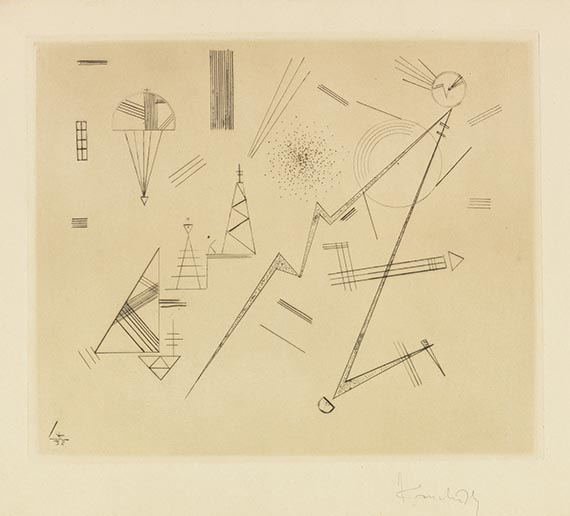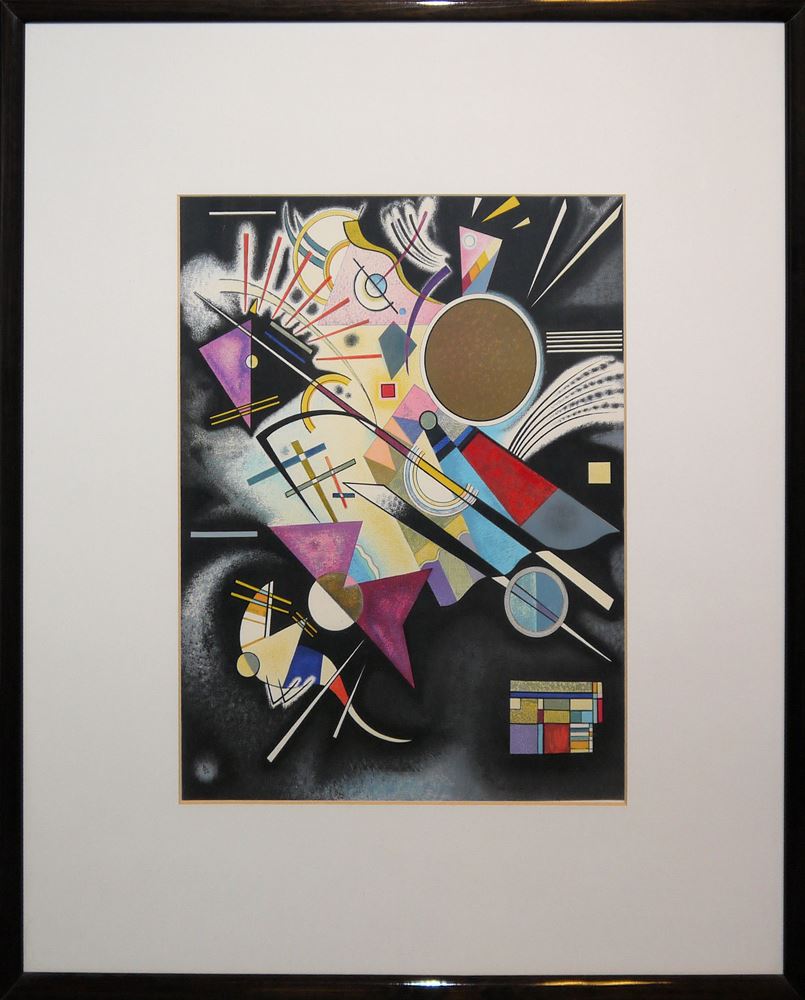WASSILY KANDINSKY Russia/France 1866-1944 Kreis u. Fleck / Cercle et tache / Circle and Spot Signed and dated VK 29. Oil on canvas, 77 x 67 cm. Executed in January 1929 Handlist IV, No 442 . PROVENANCE Gaika Scheyer, Los Angeles (1930-1945) Sidney Janis Gallery, New York Galerie Maeght, Paris Yamamura Glass Co, Ltd, Japan Kunsthalle Bern Galerie Beyeler, Basel (4530) . EXHIBITED Die Blaue Vier, Galerie Ferdinand Möller, Berlin October 1929, catalogue No. 113 Galerie Alfred Flechtheim, Berlin 1931, catalogue No. 40 An Exhibition of Paintings by Kandinsky, Valentine Gallery, New York, 15 November - 10 December 1932, catalogue No. 10 Stendahl Art Galleries, Los Angeles 1936, catalogue No. 22 Paintings by Wassily Kandinsky, San Francisco Museum of Art, July 1939, catalogue No. 14 The Blue Four, Buchholz Gallery, New York, 31 October - 25 November 1944, catalogue No. 36 Palais des Beaux-Arts, Bruxelles San Francisco Museum of Art, 1950 Kandinsky - Derrière le Miroir, Galerie Maeght, Paris 1953, catalogue No. 16 Wallraf-Richartz Museum, Köln 1958, catalogue No 31 Painters of the Bauhaus, Marlborough Fine Art Ltd, London 1962, catalogue No. 79 Moon and Space, Galerie Beyeler, Basel 1970, catalogue No. 31 . LITERATURE Galerie de France, Paris 1930, illustrated in the exhibition catalogue Hans Roethel and Jean Benjamin: Catalogue Raisonné - Kandinsky - Werkverzeichnis der Ölgemälde 1916-1944, Band II, Verlag Beck München 1984, catalogue No. 886, illustrated page 814 Will Grohmann: Wassily Kandinsky - Life and Work, 1958, page 337, illustrated page 298, page 374 . . Stockholms Auktionsverk would like to express its sincere gratitude to Dr. Vivian Endicott Barnett for her valuable contribution to the cataloguing . . WASSILY KANDINSKY was born into a wealthy family in Moscow on 4 December 1866. When his parents divorced, the 5-year-old boy stayed with his father, but was raised by an aunt to whom, many years later, he dedicated his famous theoretical treatise Über das Geistige in der Kunst (Concerning the Spiritual in Art). In 1885, he began studying law, economics and statistics at the University of Moscow. After graduating, he commenced preparation of a PhD in law, and in 1896 he was offered an associate professorship at the University of Dorpat (Tartu) in Estonia, but he declined the position. Instead of continuing his academic career, he chose to follow a different path, and that same year he moved to Munich to study painting. In his 1913 book Rückblicke (Looking Back, 1913), Kandinsky explains that there were two predominant artistic impressions that led him to take this radical decision. The first was Monet's famous Haystack, which he saw at the French exhibition in Moscow in 1896, where the object - the haystack - seemed to dissolve into itself, an impression that shook Kandinsky. The other was Wagner's opera Lohengrin, which he saw and heard at the Bolshoi Theatre that same year. Painting and music, the pillars of Kandinsky's philosophy of art. . Kandinsky made Munich his base until the outbreak of the First World War in 1914, even though he spent much of his time travelling in the company of his lady friend and artist colleague Gabriele Münter who had originally been his pupil at an art school in Munich. Kandinsky was strongly influenced by his Russian background, often referring to his home city of Moscow as his 'artistic tuning fork'. In the period 1903-07, he composed a series of symbolist paintings and wood carvings featuring traditional Russian motifs, such as the painting Begräbnis (Burial, 1907), which was one of the works to feature in Kandinsky's first exhibition in Sweden - at Gummeson's art gallery in Stockholm in 1916. Kandinsky and Münter spent several summers in the Bavarian mountain town of Murnau, where Kandinsky's symbolist painting transitioned into a more abstract, strongly coloured phase, featuring works with musicalsounding titles such as Impression, Improvisation and Composition in various numbered series
WASSILY KANDINSKY Russia/France 1866-1944 Kreis u. Fleck / Cercle et tache / Circle and Spot Signed and dated VK 29. Oil on canvas, 77 x 67 cm. Executed in January 1929 Handlist IV, No 442 . PROVENANCE Gaika Scheyer, Los Angeles (1930-1945) Sidney Janis Gallery, New York Galerie Maeght, Paris Yamamura Glass Co, Ltd, Japan Kunsthalle Bern Galerie Beyeler, Basel (4530) . EXHIBITED Die Blaue Vier, Galerie Ferdinand Möller, Berlin October 1929, catalogue No. 113 Galerie Alfred Flechtheim, Berlin 1931, catalogue No. 40 An Exhibition of Paintings by Kandinsky, Valentine Gallery, New York, 15 November - 10 December 1932, catalogue No. 10 Stendahl Art Galleries, Los Angeles 1936, catalogue No. 22 Paintings by Wassily Kandinsky, San Francisco Museum of Art, July 1939, catalogue No. 14 The Blue Four, Buchholz Gallery, New York, 31 October - 25 November 1944, catalogue No. 36 Palais des Beaux-Arts, Bruxelles San Francisco Museum of Art, 1950 Kandinsky - Derrière le Miroir, Galerie Maeght, Paris 1953, catalogue No. 16 Wallraf-Richartz Museum, Köln 1958, catalogue No 31 Painters of the Bauhaus, Marlborough Fine Art Ltd, London 1962, catalogue No. 79 Moon and Space, Galerie Beyeler, Basel 1970, catalogue No. 31 . LITERATURE Galerie de France, Paris 1930, illustrated in the exhibition catalogue Hans Roethel and Jean Benjamin: Catalogue Raisonné - Kandinsky - Werkverzeichnis der Ölgemälde 1916-1944, Band II, Verlag Beck München 1984, catalogue No. 886, illustrated page 814 Will Grohmann: Wassily Kandinsky - Life and Work, 1958, page 337, illustrated page 298, page 374 . . Stockholms Auktionsverk would like to express its sincere gratitude to Dr. Vivian Endicott Barnett for her valuable contribution to the cataloguing . . WASSILY KANDINSKY was born into a wealthy family in Moscow on 4 December 1866. When his parents divorced, the 5-year-old boy stayed with his father, but was raised by an aunt to whom, many years later, he dedicated his famous theoretical treatise Über das Geistige in der Kunst (Concerning the Spiritual in Art). In 1885, he began studying law, economics and statistics at the University of Moscow. After graduating, he commenced preparation of a PhD in law, and in 1896 he was offered an associate professorship at the University of Dorpat (Tartu) in Estonia, but he declined the position. Instead of continuing his academic career, he chose to follow a different path, and that same year he moved to Munich to study painting. In his 1913 book Rückblicke (Looking Back, 1913), Kandinsky explains that there were two predominant artistic impressions that led him to take this radical decision. The first was Monet's famous Haystack, which he saw at the French exhibition in Moscow in 1896, where the object - the haystack - seemed to dissolve into itself, an impression that shook Kandinsky. The other was Wagner's opera Lohengrin, which he saw and heard at the Bolshoi Theatre that same year. Painting and music, the pillars of Kandinsky's philosophy of art. . Kandinsky made Munich his base until the outbreak of the First World War in 1914, even though he spent much of his time travelling in the company of his lady friend and artist colleague Gabriele Münter who had originally been his pupil at an art school in Munich. Kandinsky was strongly influenced by his Russian background, often referring to his home city of Moscow as his 'artistic tuning fork'. In the period 1903-07, he composed a series of symbolist paintings and wood carvings featuring traditional Russian motifs, such as the painting Begräbnis (Burial, 1907), which was one of the works to feature in Kandinsky's first exhibition in Sweden - at Gummeson's art gallery in Stockholm in 1916. Kandinsky and Münter spent several summers in the Bavarian mountain town of Murnau, where Kandinsky's symbolist painting transitioned into a more abstract, strongly coloured phase, featuring works with musicalsounding titles such as Impression, Improvisation and Composition in various numbered series

.jpg?w=400?width=1600&quality=70)

.jpg)








Testen Sie LotSearch und seine Premium-Features 7 Tage - ohne Kosten!
Lassen Sie sich automatisch über neue Objekte in kommenden Auktionen benachrichtigen.
Suchauftrag anlegen